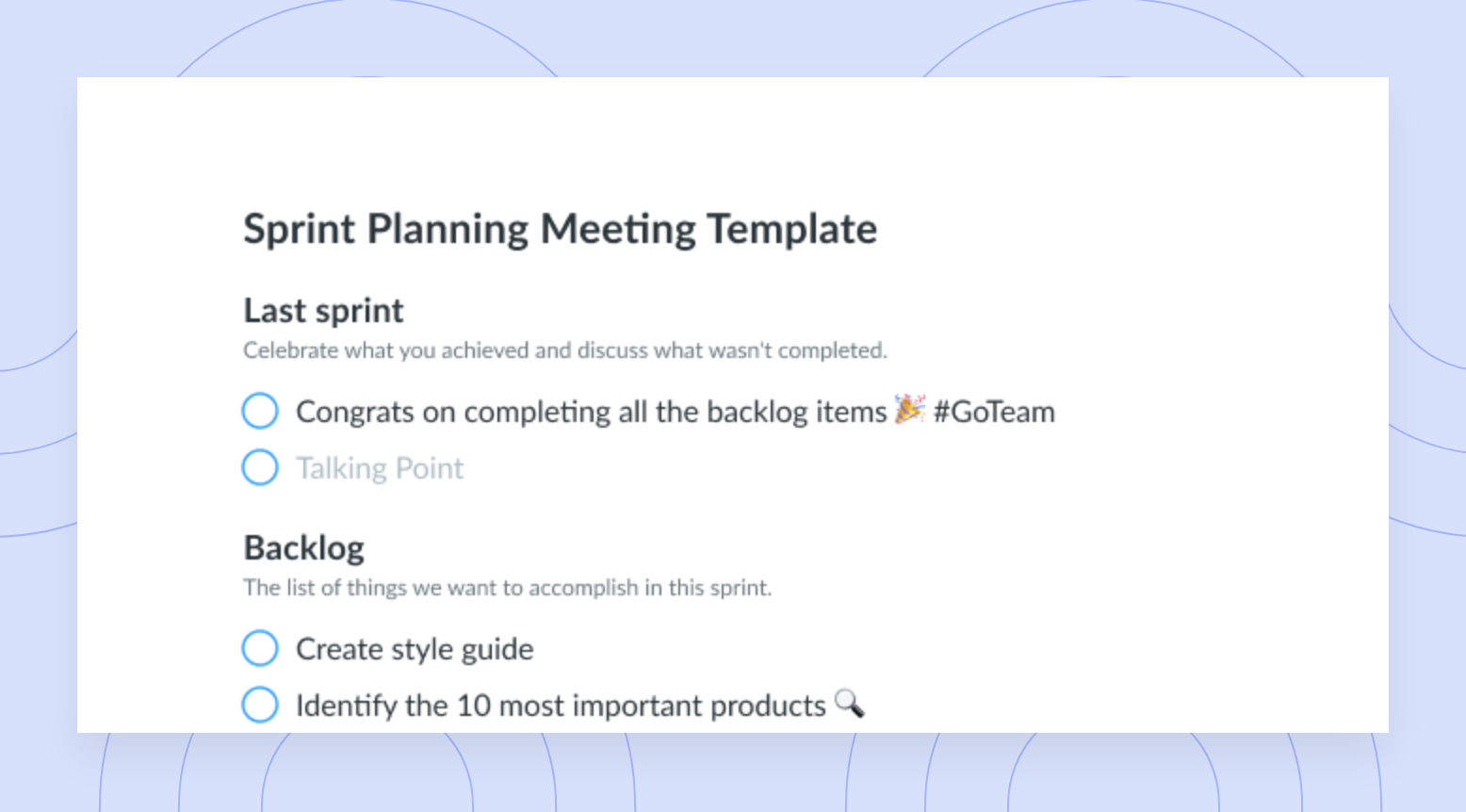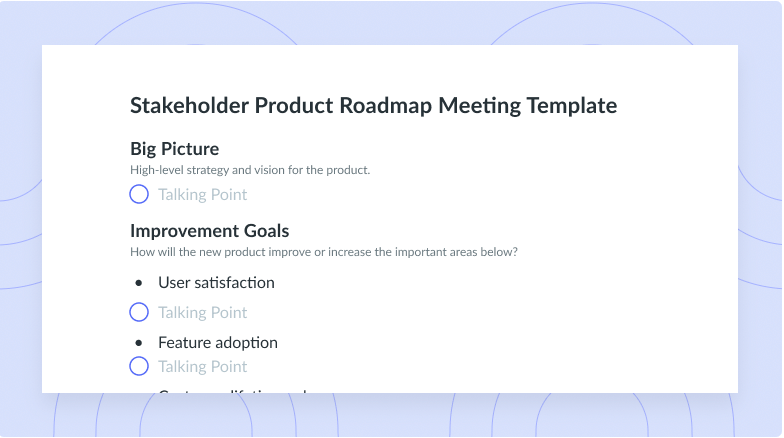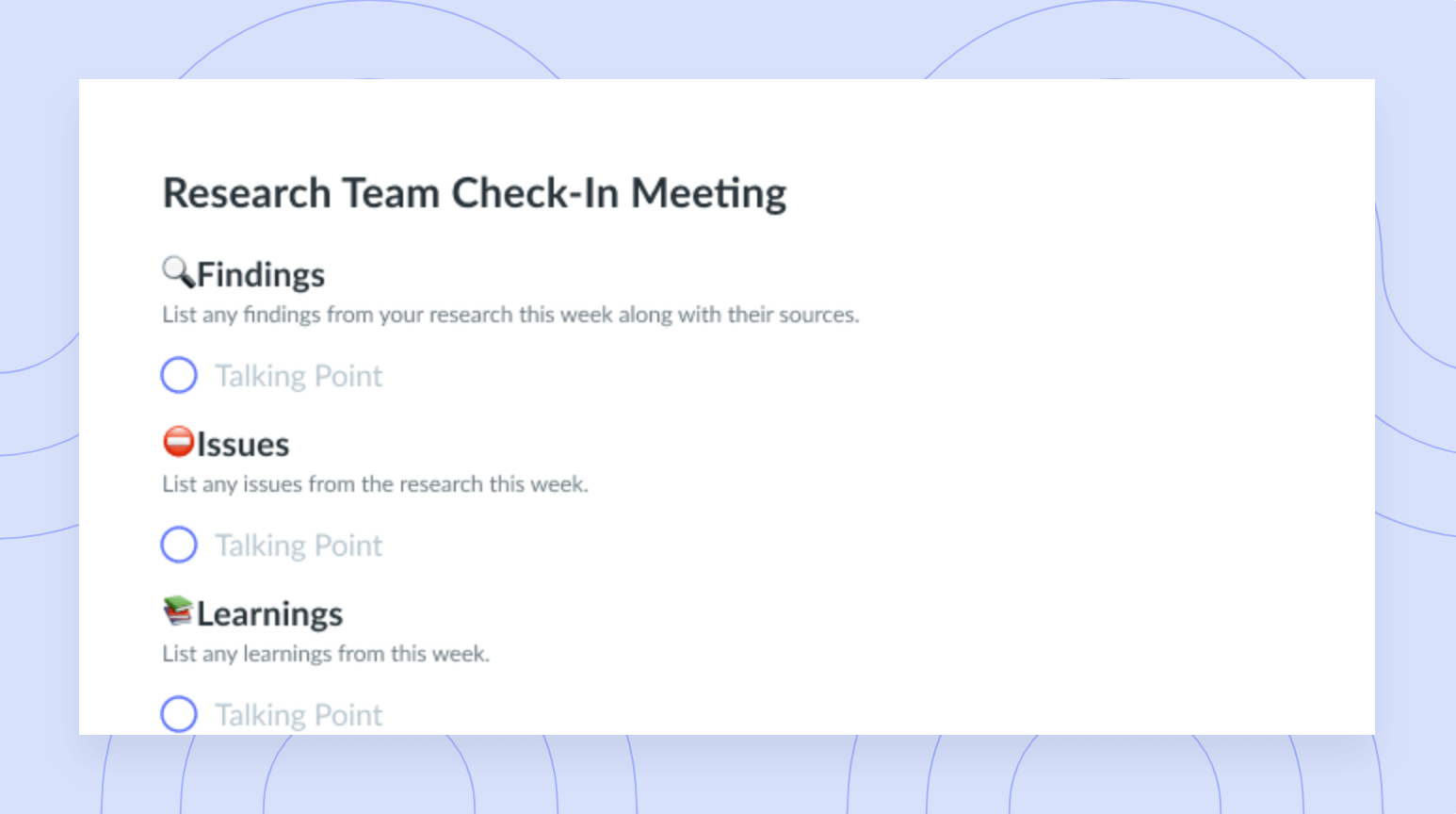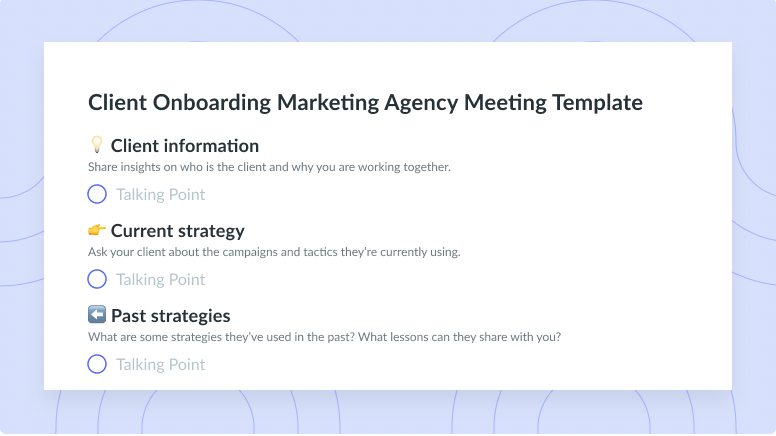Roadmap Meeting: Everything You Should Know + Helpful Tips
Roadmap meetings are vital to developing new and exciting products. Here’s how to make your next one productive for your whole team.
To develop new products and features, yotu’ll need a team of people who each bring their strengths and knowledge to the table. Roadmap meetings are a great way to gather this team. These meetings should include your managers, product owners, development representatives, and other stakeholders so you can make the best possible decisions. Read on to learn everything you need to know about roadmap meetings and how to host one effectively.
- What is a roadmap meeting?
- Who gets involved with a roadmap meeting?
- How to host a great roadmap meeting
What is a roadmap meeting?
A roadmap meeting is when a group assembles to discuss the vision of a new product. This meeting will go over the product strategy and the steps it takes to execute your strategic plan. The main goal of a roadmap meeting is to get stakeholder buy-in for your strategy or a greenlight to start product development.

Run delightful roadmap meetings
Increase meeting engagement and productivity with a collaborative agenda that the whole team can contribute to. Try using a tool like Fellow!

Who gets involved with a roadmap meeting?
Every roadmap meeting should include a product manager, a product owner, development representatives, and an executive stakeholder. Read on to discover why you need them and learn their roles in the meeting.
1Product manager
Your product manager is responsible for creating your roadmap and presenting all your strategic goals. They should know all the ins and outs of their product and target audience – that’s how they’ll impress stakeholders. Here’s a tip: Your product manager should look at and present customer data to understand the product’s strengths and weaknesses. Once they pull together their ideas and data, they can organize and host the roadmap meeting.
2Product owner
The product owner will also join the meeting and bridge the development team’s plan with the big-picture strategic plan. The product owner should really get to know each roadmap theme so they can communicate effectively with the development team. This person will also transform the roadmap strategy into a user story to guide the development team’s work.
3Development reps
The development reps help explain the resources, efforts, and timeframes the team is considering for the desired features. The development reps will also discuss whether the team can actually make the plan happen given your team’s current resources.
Typically, you only need one development team member in your roadmap meetings – say, a development manager or a department head. However, there are some cases where several reps should join the meeting. For example, you may need multiple representatives when you need input from different skill sets such as an IT manager and a software engineer.
4Executive stakeholder
A stakeholder will join your meeting when you need approval in your decision-making process for something like, for example, a new aspect of the roadmap. The executive stakeholder is the person who will give you permission to start the development process. They will also help you figure out your budget for your plan.
Try this free Stakeholder Product Roadmap Meeting Template:
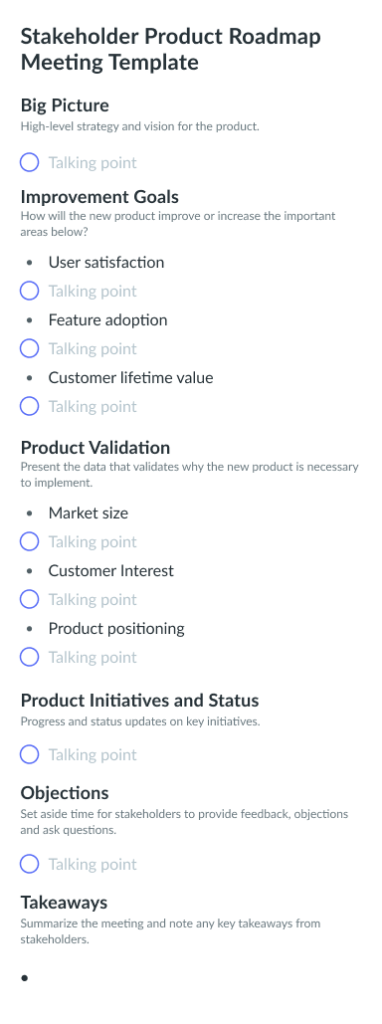
How to host a great roadmap meeting
If you’re unsure how to host a roadmap meeting, use the tips below as inspiration.
- Create and share a meeting agenda
- Invite the right team members
- Communicate your goals clearly
- Use evidence to build your roadmap
- Share examples
- Know your audience well
- Share status updates
- Use visuals
- Take meeting notes and assign action items
- Get peer feedback to improve your next roadmap meeting
1Create and share a meeting agenda
Before your roadmap meeting, you should create a meeting agenda that lists all your topics and talking points. Your meeting agenda should also list who will cover each talking point and how long each topic should take. Your agenda can guide your meeting, give it purpose, and help it stay on track. Once you finish writing your agenda, you should send it to your team before the meeting.

2Invite the right team members
To be successful in product roadmap planning, you need to have the right people in each meeting. Ideally, you want a product manager, product owner, stakeholder, and a development representative in the room. However, if you’re unable to get a product owner, for example, you could ask a project manager instead. Having the right people there from the get-go can help prevent mistakes in your planning and save time in the development process.
3Communicate your goals clearly
Once you have your team in place, you can begin the roadmap planning process. You want to spend your meeting gradually explaining your goals to your team to ensure everyone is on the same page. You can do the following to get everyone aligned.
- Talk about your big-picture product vision
- Explain your business goals and what you hope to achieve
- Discuss any limitations and guidelines that might come up with your plan
- Discuss a potential launch date
4Use evidence to build your roadmap
To ensure that your team makes the best decisions, you’ll need to provide them with reliable information. For example, before you ask your team for their input on a feature, show them your research first. That’s especially important if you have a stakeholder in your meeting. The stakeholder will likely ask to see the evidence behind your ideas, so you need concrete proof.
5Share examples
Specific examples are a great way to get someone to invest in your idea. (Would you invest in something without knowing what it does? Probably not!) To make the strongest argument, you should tie your initiatives to certain metrics when you show your stakeholders your roadmap. Here are some important considerations that your metrics can help answer.
- Product adoption: How can you get people who visit your website to become consistent product users? If you’re developing an app, how often are people signing in and using it?
- Features: Look at your product’s big list of features and figure out which are the most popular. This will help you allocate your resources to the best features so you don’t waste time on others.
- Success rate: Are your customers satisfied with your product? Is there a place where they constantly get stuck and decide to quit?
6Know your audience well
When presenting your roadmap, you need to use appropriate language for your audience. For example, if you’re speaking to people who aren’t high-tech (some stakeholders might not be), you may want to avoid buzzwords. Additionally, you want to use everyday language in your roadmap so everyone can easily understand it, even if they aren’t in your industry. You wouldn’t read a medical dictionary to an accountant, and an accountant wouldn’t read the tax code to a doctor – use common language instead.
7Share status updates
Your roadmap should show a high-level strategy, but that doesn’t mean you won’t have to go into detail about your project. The execs will want to hear status updates to dig deeper on how your project is going and how you’re using all your resources. Mainly, your stakeholders want to hear details about the feature because they’re excited about its release. They’ll also want to make sure they don’t regret their involvement in the project in the long run.
8Use visuals
There’s a chance that some people won’t remember everything you say in your meeting. That’s why visual aids are a great way to get everyone’s attention – and keep it. When you create your visual aids, try using a bunch of colors that don’t look too similar. You’ll also want to stay away from big batches of text – instead, say those descriptions out loud as your talking points. Store them in your head, not on the screen.
9Take meeting notes and assign action items
Before you host your roadmap meeting, ask a team member to join and take meeting notes. This can help you stay present at the meeting and ensure that you don’t miss anything for your summary later. During the meeting, you’ll also need to assign meeting action items. These tasks arise during the meeting for your team to handle afterward so you can get closer to that big goal.
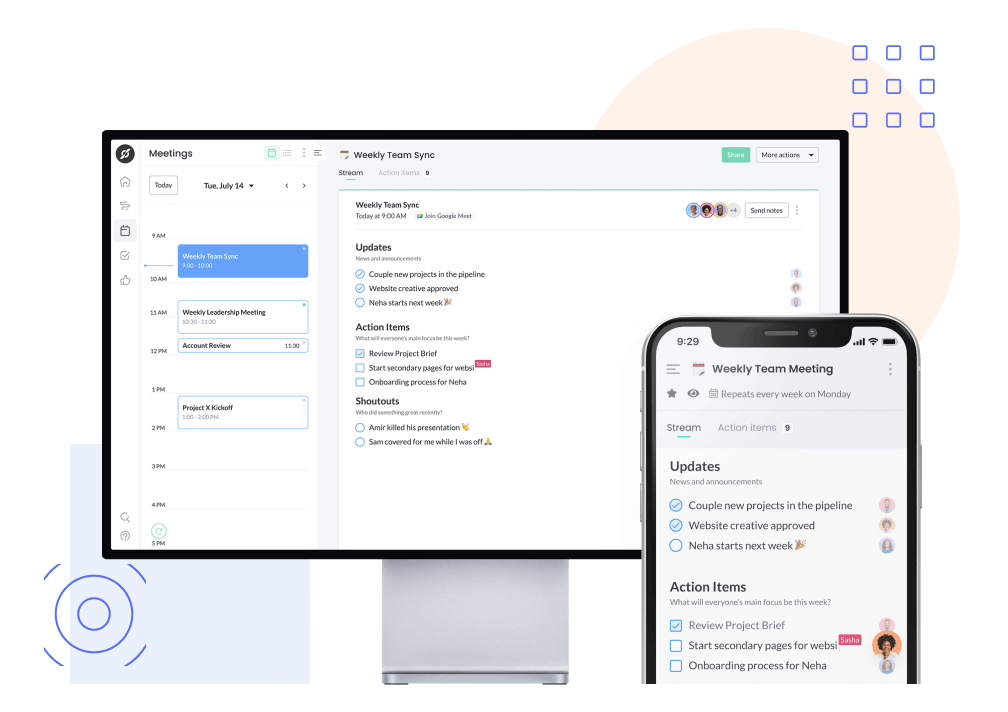
10Get peer feedback to improve your next roadmap meeting
Are your roadmap meetings running too long? Do they feel disorganized? The only way to find out is to ask for peer feedback. After the meeting, send an email asking your participants to fill out anonymous survey templates. This way, you’ll see how you’re doing and where you need to improve. And if that sounds like a lot of work, well, it’s not – if you use the right tool.
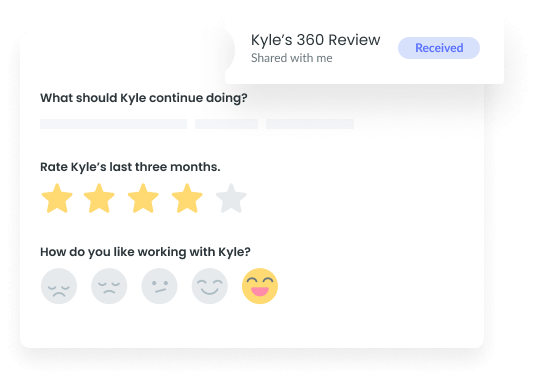
Set up your next roadmap meeting with Fellow
A roadmap meeting can help you communicate your vision and plans to stakeholders so you can develop your product the right way. Preparing for these important meetings is easier when you have a tool for building meeting agendas and getting feedback. With Fellow, you can do both – and assign action items and take meeting notes. Before you know it, you’ll be developing and finalizing a perfect new product.






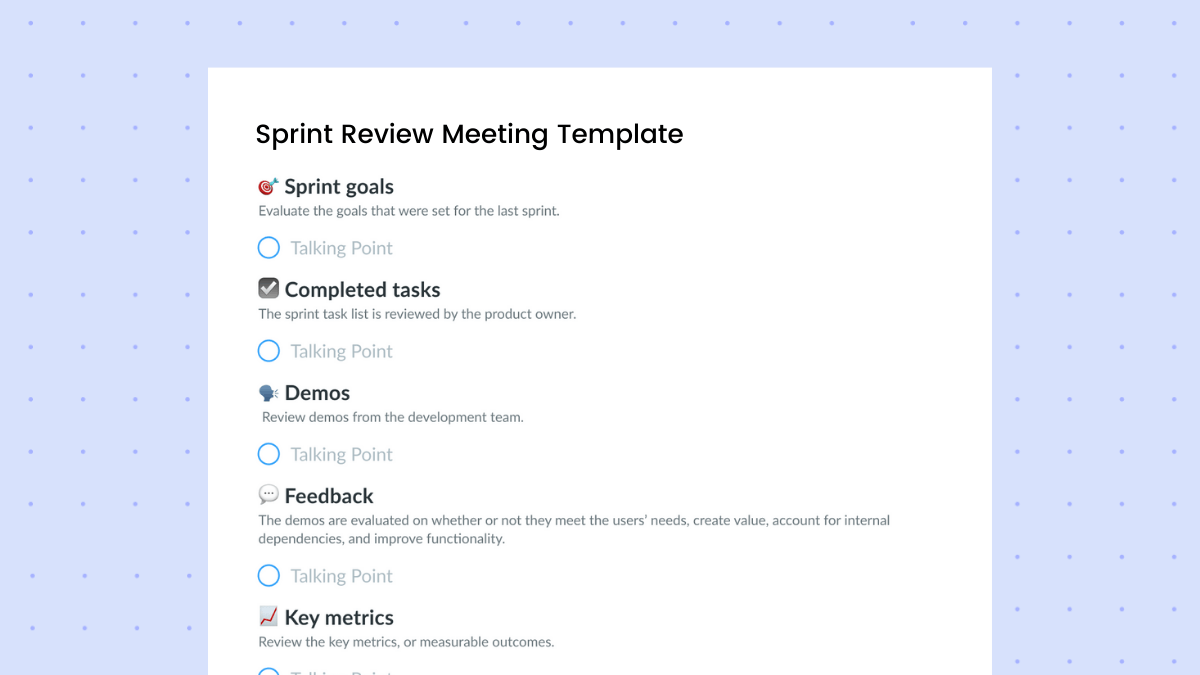
![What to Do When Your Meeting Attendees Don’t Show Up [+ Free Email Templates]](https://fellow.app/wp-content/uploads/2022/05/When-Meeting-Attendees-Dont-Show-Up-2.jpg)


